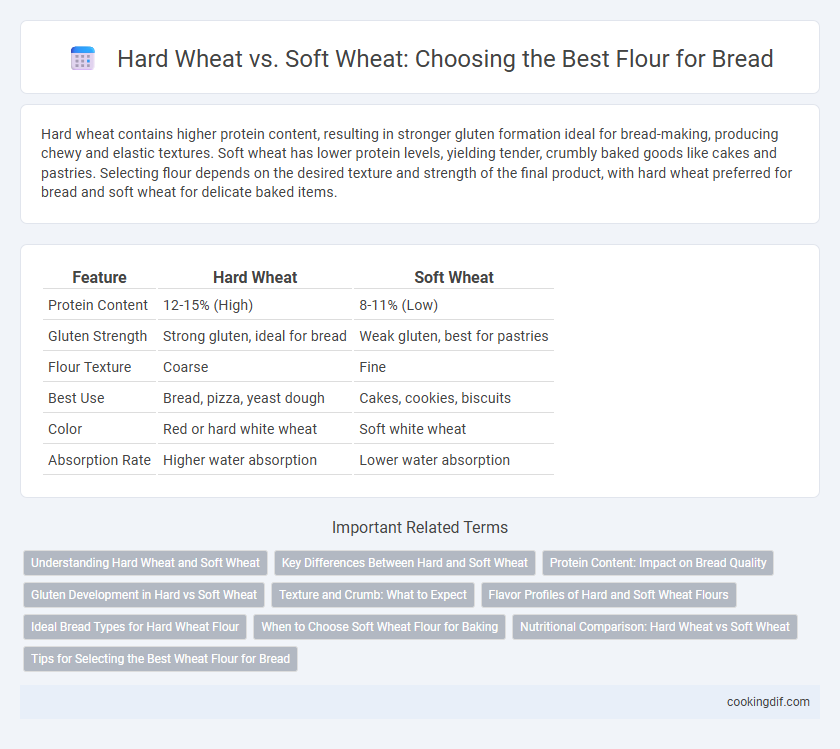Hard wheat contains higher protein content, resulting in stronger gluten formation ideal for bread-making, producing chewy and elastic textures. Soft wheat has lower protein levels, yielding tender, crumbly baked goods like cakes and pastries. Selecting flour depends on the desired texture and strength of the final product, with hard wheat preferred for bread and soft wheat for delicate baked items.
Table of Comparison
| Feature | Hard Wheat | Soft Wheat |
|---|---|---|
| Protein Content | 12-15% (High) | 8-11% (Low) |
| Gluten Strength | Strong gluten, ideal for bread | Weak gluten, best for pastries |
| Flour Texture | Coarse | Fine |
| Best Use | Bread, pizza, yeast dough | Cakes, cookies, biscuits |
| Color | Red or hard white wheat | Soft white wheat |
| Absorption Rate | Higher water absorption | Lower water absorption |
Understanding Hard Wheat and Soft Wheat
Hard wheat grains have a higher protein content, typically around 12-15%, which contributes to stronger gluten formation essential for bread with a chewy texture and good structure. Soft wheat contains lower protein levels, approximately 8-11%, making its flour ideal for tender baked goods like cakes and pastries due to a finer crumb and softer consistency. Selecting between hard and soft wheat flour depends on the desired end product, balancing gluten strength and texture for optimal baking results.
Key Differences Between Hard and Soft Wheat
Hard wheat contains higher protein content, typically 12-15%, which produces strong gluten ideal for bread and pizza dough requiring elasticity and rise. Soft wheat has lower protein, around 7-9%, making it suitable for tender baked goods like cakes and pastries where a delicate crumb is desired. The difference in gluten strength directly influences flour selection depending on the texture and structure needed in the final bread product.
Protein Content: Impact on Bread Quality
Hard wheat flour contains higher protein content, typically ranging from 12% to 14%, which enhances gluten development and results in bread with superior structure, chewiness, and volume. Soft wheat flour, with protein content usually between 7% and 9%, produces tender and fine-textured baked goods but yields bread with lower elasticity and less rise. Choosing the right protein level is crucial for achieving the desired bread quality, as higher protein promotes stronger gluten networks essential for artisan and sandwich breads.
Gluten Development in Hard vs Soft Wheat
Hard wheat flour contains higher protein levels, typically 12-14%, which leads to greater gluten development essential for bread's structure and chewiness. Soft wheat flour has lower protein content, around 8-10%, producing less gluten, making it ideal for tender baked goods like cakes and pastries. The gluten matrix in hard wheat provides elasticity and strength, critical for yeast-leavened breads requiring gas retention during fermentation.
Texture and Crumb: What to Expect
Hard wheat flour produces bread with a denser, chewier texture and a firm crumb due to its high protein content, which enhances gluten development. Soft wheat flour yields a tender, light crumb and a finer texture, ideal for cakes and pastries rather than artisanal breads. Choosing between hard and soft wheat flour directly affects the bread's structure, chewiness, and overall mouthfeel.
Flavor Profiles of Hard and Soft Wheat Flours
Hard wheat flour contains higher protein and gluten, producing a chewier texture and a nutty, robust flavor ideal for breads and pizza doughs. Soft wheat flour has lower protein and gluten, yielding a tender crumb and a mild, sweet taste perfect for cakes, pastries, and delicate baked goods. The distinct flavor profiles of hard and soft wheat flours significantly influence the texture and taste of the final baked product.
Ideal Bread Types for Hard Wheat Flour
Hard wheat flour, with its high protein and gluten content, is ideal for bread types requiring strong dough structure and elasticity, such as artisan loaves, baguettes, and sandwich bread. The robust gluten matrix formed provides excellent gas retention, resulting in a chewy texture and well-risen crumb. This flour excels in yeast-leavened bread recipes that demand extended fermentation and kneading for optimal volume and crust quality.
When to Choose Soft Wheat Flour for Baking
Soft wheat flour is ideal for baking tender, delicate goods like cakes, pastries, and biscuits due to its lower protein content, typically around 8-10%, which results in less gluten formation. When choosing flour for recipes requiring a fine crumb and light texture, soft wheat flour enhances softness and moisture retention. Bakers aiming for fluffy, melt-in-the-mouth baked items should select soft wheat flour to achieve optimal results.
Nutritional Comparison: Hard Wheat vs Soft Wheat
Hard wheat flour contains higher protein content, typically ranging from 12% to 15%, which contributes to stronger gluten development and better bread structure. Soft wheat flour has lower protein levels, around 8% to 10%, making it ideal for tender pastries and cakes but less suitable for yeast bread. Nutritionally, hard wheat generally provides more fiber, vitamins, and minerals like iron and magnesium compared to soft wheat, enhancing its benefits for whole grain bread consumption.
Tips for Selecting the Best Wheat Flour for Bread
Hard wheat contains higher protein content, typically around 12-15%, making it ideal for bread flour as it develops stronger gluten, resulting in a chewy texture and better rise. Soft wheat, with lower protein levels around 7-9%, is best suited for pastries and cakes, providing a tender crumb but not enough strength for bread structure. For optimal bread-making, choose hard wheat flour labeled as bread flour or strong flour to ensure adequate gluten formation and superior dough elasticity.
Hard wheat vs Soft wheat for flour selection Infographic

 cookingdif.com
cookingdif.com